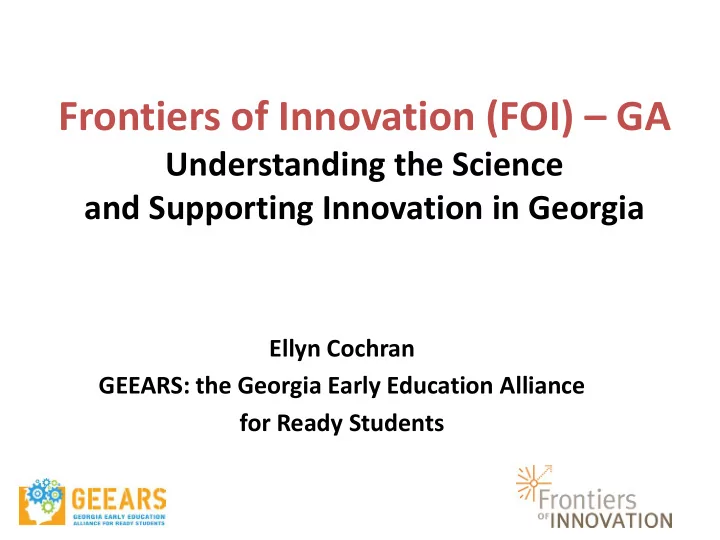

Frontiers of Innovation (FOI) – GA Understanding the Science and Supporting Innovation in Georgia Ellyn Cochran GEEARS: the Georgia Early Education Alliance for Ready Students
The Foundation of a Successful Society is Built in Early Childhood Successful Parenting of Next Generation Educational Econom ic Responsible Lifelong Achievem ent Productivity Citizenship Health Slide courtesy of the Center on the Developing Child at Harvard University. 2
Three Core Concepts of Developm ent 1 Brain Architecture Is Established Early in Life and Supports Lifelong Learning, Behavior, and Health 2 Stable, Caring Relationships and “Serve and Return” Interaction Shape Brain Architecture 3 Toxic Stress in the Early Years of Life Can Derail Healthy Development Slide courtesy of the Center on the Developing Child at Harvard University. 3
Play Video: http://developingchild.harvard.edu/resources/multimedia/videos/three_core_concepts/ brain_architecture/ 4
Brain Architecture Supports Lifelong Learning, Behavior, and Health • Early experiences shape brain architecture. • Simple skills come first; more complex skills build on top of them. • A strong foundation in the early years improves the odds for positive outcomes and a weak foundation increases the odds of problems later in life. 5
Experiences Shape Brain Architecture 70 0 neural connections per second in the early years 14 years 6 years Birth Image source: Conel, JL. 6
Play Video: http://developingchild.harvard.edu/resources/multimedia/videos/three_core_concepts /serve_and_return/ 7
Serve & Return Builds Brains and Skills • Ongoing, reliable interaction with trusted adults is essential for the development of healthy brain circuits. • Systems that support the quality of relationships in early care settings, communities, and homes help build brain architecture. 8
Barriers to Educational Achievement Emerge at a Very Young Age 120 0 Cum ulative Vocabulary (Words) 10 0 0 College Educated Parents 8 0 0 Working Class Parents 6 0 0 Welfare Parents 4 0 0 20 0 16 m os. 24 m os. 36 m os. Child ’ s Age (Months) Graph Courtesy: Center on the Developing Child at Harvard University Data Source: Hart & Risley (1995) 9
10
Relationships Buffer Toxic Stress • Learning how to cope with moderate, short-lived stress can build a healthy stress response system. • Toxic stress—when the body’s stress response system is activated excessively—can weaken brain architecture. • Without caring adults to buffer children, toxic stress can have long-term consequences for learning, behavior, and both physical and mental health. 11
Significant Adversity Impairs Development in the First Three Years Developm ental Delays 100% Children with 80% 60% 40% 20% 1-2 3 4 5 6 7 Num ber of Risk Factors Graph Courtesy: Center on the Developing Child at Harvard University Data Source: Barth, et al. (2008) 12
Chronic Diseases Associated W ith Childhood Adversity Dom inate U.S. Health Care Costs Four of Top Ten Most Costly Diagnoses = $ 2 7 4 billion $100 billion Cancer $81 billion $ 1 0 7 Annual Cost $80 billion billion $60 billion $ 7 3 billion $40 billion $ 5 1 $ 4 3 billion billon $20 billion Heart Diabetes Mental Hypertension Conditions # 7 Disorders # 8 # 1 # 4 Slide courtesy of the Center on the Developing Child. Source: Agency for Healthcare Research and Quality (2010)
Applying the Science to Our Policies The FOI Approach Play Video: http://developingchild.harvard.edu/resources/multimedia/videos/theory_of_change / 14
Building a Learning Com m unity to Design, Test, Refine, and Scale New I deas Horizontal Netw orking Researchers I nnovating Practitioners States & Policym akers Provinces Philanthropists Horizontal Netw orking W orking Groups I nnovating ( I ncubators & Com m unities Engines) Horizontal Netw orking I nnovating Program s Vertical I ntegration Slide courtesy of the Center on the Developing Child at Harvard University. Vertical Alignm ent
Georgia as ‘Innovation by Design’ State Desired Outcom e: Georgia as a thriving science-based innovation system that is: • Achieving breakthroughs in early childhood outcomes in Georgia • A major contributor – through its ideas, people, capabilities and experience – to advancing science- based innovation in the early childhood field more broadly • A compelling example for other states of what a thriving science-based innovation system can look like and the potential pathways to get there
Increasing the Impact of Current Investments in Georgia Requires Three Strategies (Campaign for Grade Level Reading) Enhance quality and take Science-base innovation: effective models to scale Formulate enhanced theories of change, test new ideas, and learn from interventions that don ’ t work Build strong systems for coordinated service delivery and data management
FOI Process in Georgia System s Scan •Currently in Charter Development Process • Charter Development Team Members • three state agencies (Governor’s Office, Early Care and Learning, and Public Health) • Child development advocacy group (Center contact – facilitator) • Representative from site-based FOI partnership in state • End Result Identified: All students in Georgia reading at grade- level in third grade • Group is identifying a target issue – Problem to solve • Development of social-emotional (SE) skills and early identification of social-emotional challenges in early childhood
Planting the Seeds of Innovation Late Majority Early Majority Status Quo Until Get to State Proven Otherwise of the Art Early Adopters Adopt & Adapt New Ideas Laggards I nnovators Basic capability Generate & issues that Test New Ideas need to be fixed Adapted from Everett Rogers, Diffusion of Innovations (2003)
Next Steps Design W orkshop • Include local and FOI national researchers with state agencies, practitioners, and philanthropists • Craft initial set of strategies to achieve desired results, grounded in science, able to be implemented. Solution Collaboration • Translate strategy to practice using rapid-cycle learning while holding fast to intended results • Will be setting innovations partners inside Early Education Empowerment Zones (E 3 Zs) Assistance from Other Agencies
Recommend
More recommend